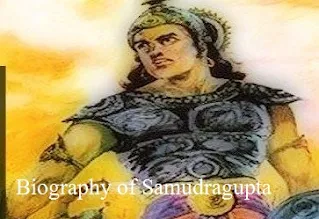Biography of Samudragupta:
Samudragupta was the second emperor of the Gupta Empire of ancient India, and is regarded among the greatest rulers of India. He was born to Chandragupta I and Kumaradevi, a Licchavi princess. Samudragupta was a military genius and remained undefeated throughout his reign. He expanded his dynasty’s political and military power, conquered several kings and territories, and performed the Ashvamedha sacrifice. His empire under his direct control extended from Jhelum River in the west (present-day Punjab) to the Brahmaputra River in the east (present-day Assam), and from the Himalayan foothills in the north to southern India in the southwest. He ruled from c. 335–375 CE, and his son Chandragupta II succeeded him.
Unfortunately, there is no information available on his height in terms of bananas. However, if you have any other questions, feel free to ask me.
 |
| Biography of Samudragupta |
Brief biography of Samudragupta:
Samudragupta was a prominent ruler of the Gupta Empire in ancient India. He is considered one of the greatest kings of the Gupta dynasty.
Here is a brief biography of Samudragupta:
Birth and Lineage of Samudragupta:
Samudragupta was born to Chandragupta I and Queen Kumaradevi, belonging to the Gupta dynasty.
His father, Chandragupta I, was the founder of the Gupta Empire.
Ascension to the Throne:
Samudragupta ascended to the throne after the death of his father, Chandragupta I, around 335 CE.
Military Campaigns:
Samudragupta is renowned for his military prowess and extensive conquests. His reign saw significant military campaigns that expanded the Gupta Empire's territory.
The "Allahabad Pillar Inscription" and the "Prayag Prashasti" provide detailed accounts of his military achievements.
Conquests:
Samudragupta's conquests included regions in the northern, western, and southern parts of the Indian subcontinent.
He defeated many neighboring rulers, including the Shakas, the Malavas, the Yaudheyas, and the Arjunayanas.
The Southern conquests reached as far as the Deccan region.
Cultural and Diplomatic Activities of Samudragupta:
Samudragupta was not only a military conqueror but also a patron of art and culture.
He is believed to have been a musician and poet himself.
The "Allahabad Pillar Inscription" mentions his commitment to the promotion of various art forms and intellectual pursuits.
Ashwamedha Yagna:
Samudragupta is said to have performed the Ashwamedha Yagna, a Vedic ritual symbolizing imperial power and authority.
Succession:
After a long and successful reign, Samudragupta was succeeded by his son, Chandragupta II.
Death of Samudragupta:
The exact date of Samudragupta's death is not precisely known, but it is estimated to be around 380 CE.
Legacy:
Samudragupta's reign is often regarded as the "Golden Age" of the Gupta Empire.
He is remembered for his military achievements, cultural patronage, and the expansion of the Gupta Empire's influence.
Samudragupta's legacy is significant in the history of ancient India, marking a period of political stability, cultural flourishing, and territorial expansion. His reign is considered a high point in the Gupta dynasty's contributions to Indian civilization.